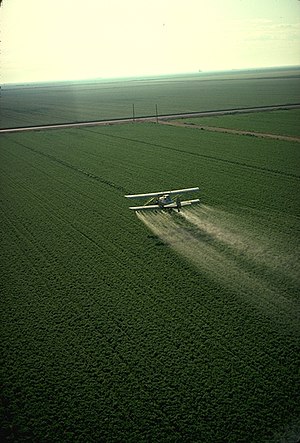 Image via WikipediaTo start off, the colloidal humus particles are the convoys that transfer most of the minerals from the soil solution to the root hairs. Each humus particle is negatively charged and will, attract the positive elements, such as potassium, sodium, calcium, magnesium, manganese, aluminum, boron, iron, copper and other metals. When sodium nitrate is dumped into the soil year after year, in large doses, a radical change takes place on the humus articles.
Image via WikipediaTo start off, the colloidal humus particles are the convoys that transfer most of the minerals from the soil solution to the root hairs. Each humus particle is negatively charged and will, attract the positive elements, such as potassium, sodium, calcium, magnesium, manganese, aluminum, boron, iron, copper and other metals. When sodium nitrate is dumped into the soil year after year, in large doses, a radical change takes place on the humus articles.The very numerous sodium ions (atomic particles) will eventually crowd out the other ions, making them practically unavailable for plant use. The humus becomes coated with sodium, glutting the root hairs with the excess. Finally, the plant is unable to pick up the minerals that it really needs.
So, with chemical fertilizers, in short, you have short-term results, and long-term damage to the soil, ground water and to our health.
Another reason to avoid the use of chemicals and pesticides is that long term use of such chemicals can deplete the soil and leave it unable to sustain further growth. In many cases beds of perennials suddenly stop blooming for no apparent reason, and the culprit is often found to be the overuse of chemical fertilizers, herbicides and pesticides.
Chemicals that are applied to plants can often seep into the water supply thus contaminating it. While it’s true that our drinking water does go through a filtration process, it’s been proven many times over that this process doesn’t remove ALL of the harmful contaminants.
 Image via WikipediaIt has also been proven that certain chemicals can cause diseases, birth defects, and other hazardous health problems. All one needs to do is watch the movie “Erin Brokovich” to see what chemical contamination of water can do to a body.
Image via WikipediaIt has also been proven that certain chemicals can cause diseases, birth defects, and other hazardous health problems. All one needs to do is watch the movie “Erin Brokovich” to see what chemical contamination of water can do to a body.Consumers worry about filthy slaughterhouses, e-coli, salmonella and fecal contamination. The CDC estimates that 76 million American suffer food poisoning every year. On the other hand, at this time, there are no documented cases of organic meat, poultry or dairy products setting off a food poisoning outbreak in the United States.
Consumers are also concerned about toxic sewage used as fertilizer on conventional farms. Organic farming prohibits the use of sewage sludge.
Some also worry about untested and unlabeled genetically engineered food ingredients in common supermarket items. Genetically engineered ingredients are now found in 60 percent to 75 percent of all U.S. foods. Although polls indicate 90 percent of Americans want labels on gene-altered foods, government and industry refuse to label. Organic production forbids genetic engineering.
Eating organic eliminates, or minimizes, the risk from poisoning from heavy metals found in sewage sludge, the unknowns of genetically modified food, the ingestion of hormone residues, and the exposure to mutant bacteria strains. It also reduces the exposure to insecticide and fungicide residues.
Residues from potentially carcinogenic pesticides are left behind on some of our favorite fruits and vegetables - in 1998, the FDA found pesticide residues in over 35 percent of the food tested. Many U.S. products have tested as being more toxic than those from other countries. What's worse is that current standards for pesticides in food do not yet include specific protection for fetuses, infants, or young children despite major changes to federal pesticide laws in 1996 requiring such reforms.
It is certainly in the best interests of the human population to avoid chemicals in our food, but it’s also better for our planet as well. Chemicals can affect the soil making it less fertile. They destroy important parts of the natural eco-system. All plants and animals serve some sort of purpose – even if that purpose isn’t especially obvious. By taking these components out of the natural life cycle, we are endangering our environment in ways we can’t necessarily see outright, but that danger is there.
So it becomes obvious that growing your food naturally is the best way to go. For more on organic, natural, and sustainable gardening, just visit http://www.newholisticliving.com/sustainablegardening.html, or check out the resources below.


No comments:
Post a Comment